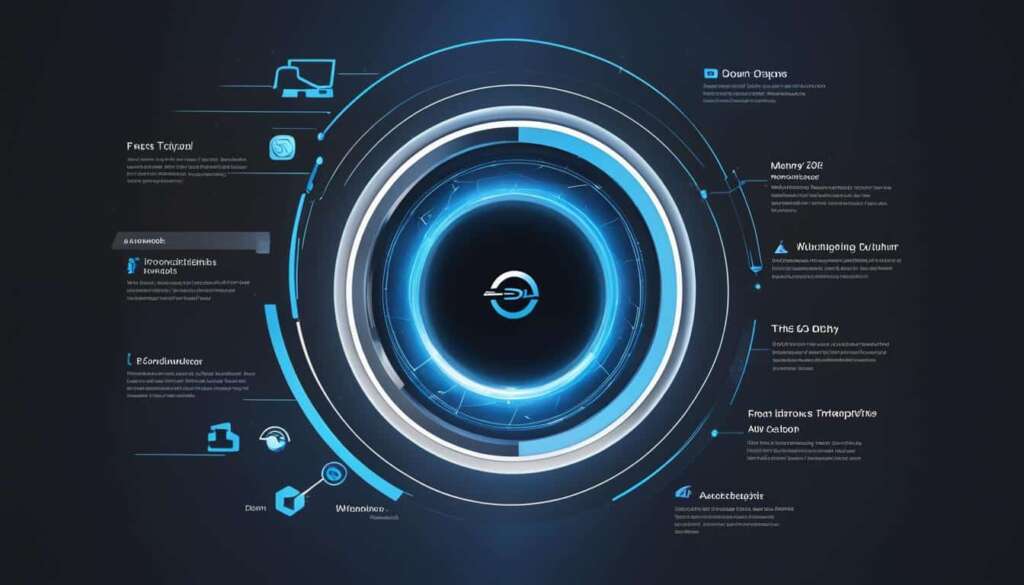Table of Contents
Welcome to our comprehensive guide on DISM (Deployment Image Servicing and Management), a crucial Windows tool for maintenance and repair tasks. In this guide, we will explore what DISM is, how it works, best practices for using it, image servicing and management capabilities, its limitations, and its integration within the Windows operating system. Whether you are an IT administrator or a Windows enthusiast, this guide will provide you with valuable insights into DISM and its functionalities.
What is DISM and How Does it Work?
DISM, which stands for Deployment Image Servicing and Management, is a powerful Windows tool designed for servicing and managing Windows images. It plays a crucial role in tasks related to Windows PE (Preinstallation Environment), Windows Recovery Environment, and Windows Setup.
You can access DISM through the command line or Windows PowerShell, as it is built directly into the Windows operating system. This makes it easily accessible and convenient for IT administrators to utilize its capabilities.
DISM enables administrators to perform various tasks, such as mounting, modifying, and managing Windows images. This versatility makes DISM an essential tool for deployment, maintenance, and repair procedures in the Windows ecosystem.
Let’s explore some of the key features and functionalities of DISM:
- Image Servicing: DISM allows you to service Windows images, ensuring they are up to date, secure, and optimized for performance.
- Windows PE Maintenance: Windows PE images can be modified, customized, and serviced using DISM, facilitating efficient deployment and recovery operations.
- Windows Recovery Environment: DISM provides tools for managing Windows Recovery Environment, enabling administrators to perform system repairs and troubleshoot boot-related issues.
- Windows Setup: DISM assists in preparing Windows Setup images, making it easier to deploy new installations and configure system settings.
With DISM at their disposal, IT administrators have the means to effectively manage Windows images, ensuring system stability, security, and optimal performance.
Sample Table: DISM Command Examples
| Command | Description |
|---|---|
| DISM /Online /Cleanup-Image /CheckHealth | Checks the health of the Windows image and identifies potential issues. |
| DISM /Online /Cleanup-Image /ScanHealth | Scans the Windows image for any corruption or errors. |
| DISM /Online /Cleanup-Image /RestoreHealth | Restores the Windows image by repairing any identified issues. |
| DISM /Online /Cleanup-Image /StartComponentCleanup | Cleans up the Windows component store, freeing up disk space. |
Best Practices for Using DISM
When using DISM, there are several best practices that IT administrators should follow to ensure efficient Windows maintenance. These practices contribute to a smoother experience and enhance the effectiveness of DISM in managing Windows images.
Elevate Permissions for Command-line Tools
To maximize the functionality of DISM, it is advisable to run command-line tools with elevated permissions. This ensures that DISM has the necessary access to system resources and can perform the required tasks accurately and efficiently.
Disable Antivirus Tools
Prior to running DISM commands, it is recommended to temporarily disable antivirus tools. This prevents any interference from antivirus scans that may unintentionally interrupt the servicing process or flag legitimate DISM operations as suspicious.
Service the Windows Image Offline
Performing Windows image servicing tasks offline offers several advantages. It eliminates potential conflicts with running processes and minimizes the risk of file corruption or inconsistencies during servicing operations. By working offline, IT administrators can ensure the integrity and stability of the Windows image being serviced.
Change International Settings using DISM
DISM provides the capability to modify and update international settings within the Windows image. IT administrators can use DISM to configure language preferences, time zones, and regional settings during the deployment or servicing process. This feature enables customization according to specific regional requirements or user preferences directly from DISM.
Utilize Log Files for Troubleshooting
When troubleshooting issues related to DISM operations, IT administrators should utilize log files. DISM generates detailed logs that provide valuable insights into any errors or issues encountered during the servicing process. Analyzing these logs helps identify and resolve problems more efficiently, ensuring successful Windows maintenance.
Mindful Package Locations
When working with DISM, it is crucial to be aware of the locations of package files. Make sure that DISM is pointing to the correct directories or network locations where the required packages are stored. Incorrect package locations can lead to errors during the servicing process, and accurate package management ensures optimal DISM performance.
Scan for Corruption and Verify System File Integrity
Regularly scanning for corruption within the Windows image and verifying the integrity of system files is essential for maintaining a healthy operating system. DISM offers commands to detect and repair corrupted files, ensuring the stability and reliability of the Windows image. Regular scans and integrity checks contribute to a robust Windows maintenance routine.
Improve Security for Windows Images
Enhancing security for Windows images is a critical aspect of Windows maintenance. DISM provides options to enable additional security features, apply security hardening configurations, and manage system vulnerabilities. IT administrators should leverage DISM’s capabilities to reinforce security measures and protect Windows images from potential threats.
Implementing these best practices when using DISM empowers IT administrators in executing efficient Windows maintenance tasks. By following these guidelines, DISM can be utilized to its full potential, ensuring the smooth operation and management of Windows images.
| Best Practices | Benefits |
|---|---|
| Elevate permissions for command-line tools | Optimize DISM functionality |
| Disable antivirus tools | Prevent interference during DISM operations |
| Service the Windows image offline | Minimize conflicts and file corruptions |
| Change international settings using DISM | Customize language preferences and regional configurations |
| Utilize log files for troubleshooting | Efficiently identify and resolve DISM issues |
| Mindful package locations | Ensure accurate package management |
| Scan for corruption and verify system file integrity | Maintain a healthy Windows image |
| Improve security for Windows images | Enhance system protection against vulnerabilities |
Image Servicing and Management with DISM
DISM (Deployment Image Servicing and Management) provides IT administrators with a comprehensive set of commands and options for servicing and managing Windows images. This powerful tool enables efficient maintenance and customization of Windows installations, ensuring optimal performance and stability.
Here are some key features and capabilities of DISM:
- List Image Index Numbers: DISM allows administrators to view a list of available image index numbers within a Windows image, providing a clear overview of the available options.
- Verify Architecture: With DISM, administrators can verify the architecture of a Windows image to ensure compatibility and proper deployment on target devices.
- Append or Apply an Image: DISM enables the addition or application of specific image files to a Windows image, allowing for customization and expansion of the installation.
- Capture or Delete an Image: It is possible to capture a customized Windows image using DISM, as well as remove unnecessary images from the installation, freeing up valuable disk space.
- Export or Apply Provisioning Packages: DISM supports the export and application of provisioning packages, allowing for streamlined deployment and management of settings, applications, and configurations across multiple devices.
- Scan and Repair WIM Store: DISM can scan and repair the Windows Imaging Format (WIM) store, ensuring the integrity and reliability of the stored images.
- Repair Corrupted System Files: By utilizing DISM, administrators can repair corrupted system files within a Windows image, resolving system errors and improving overall stability.
DISM simplifies the management of Windows images, offering a wide range of tools and functionalities that streamline deployment, customization, and maintenance processes. Whether used for enterprise-wide installations or individual device management, DISM is an indispensable resource for IT administrators.

Testimonials
“DISM revolutionized our Windows image management process. Its robust set of commands allowed us to easily modify and deploy customized installations across our organization. Highly recommended!” – Jane Stevens, IT Manager
Limitations of DISM
Despite its power and versatility, DISM does have some limitations that IT administrators need to be aware of when using it for Windows deployment and maintenance tasks. Understanding these limitations is crucial for effective usage of the tool.
Version Compatibility
DISM’s functionality and supported features may vary depending on the version of the Windows operating system. IT administrators should ensure that they are using a compatible version of DISM for their target Windows image to avoid any compatibility issues.
Remote Installation Not Supported
DISM does not provide support for remote installation of Windows images. IT administrators cannot perform DISM operations on remote systems directly. Instead, alternative methods need to be employed for remote deployment and management.
Limitations with Answer File Usage
Answer files, which automate the installation and configuration process, have certain limitations when used in conjunction with DISM. Some configuration options may not be supported or may require additional steps. Careful consideration is required when utilizing answer files with DISM.
Restrictions on Multiple Servicing Commands
DISM restricts the use of multiple servicing commands within a single operation. IT administrators need to execute separate DISM commands for each servicing operation they wish to perform, allowing for limited automation and efficiency.
Wildcards Not Supported
While DISM provides powerful command-line functionality, it does not support the use of wildcards in command lines. This limitation means that administrators cannot use wildcards to perform batch operations or target specific files or directories.
These limitations highlight the importance of understanding the capabilities and constraints of DISM when using it for Windows deployment and maintenance tasks. Administrators should consider these limitations when planning their deployment strategies and be prepared to work within the confines of these restrictions.
To overcome these limitations, IT administrators can explore alternative tools and methods, or combine DISM with other deployment and management solutions to create a comprehensive and efficient workflow.
| Limitation | Description |
|---|---|
| Version compatibility | Different versions of DISM may have varying functionality and supported features. |
| Remote installation not supported | DISM cannot be used for remote installation of Windows images. |
| Limitations with answer file usage | Answer files may have certain limitations when used with DISM. |
| Restrictions on multiple servicing commands | DISM restricts the execution of multiple servicing commands within a single operation. |
| Wildcards not supported | DISM does not support the use of wildcards in command lines. |
DISM in the Windows Operating System
DISM (Deployment Image Servicing and Management) is a valuable command-line tool that comes built-in with the Windows operating system. It provides essential functionalities for various Windows installation and maintenance tasks. To access DISM, navigate to the c:\windows\system32 folder, and execute it from any location in the command prompt as an administrator. However, for older Windows versions or different DISM versions, you may need to download and install the Windows Assessment and Deployment Kit (Windows ADK).
DISM has become a staple tool in the Windows ecosystem due to its versatility and efficiency in managing Windows installations. Whether you’re deploying a new Windows image, repairing system files, or modifying the configuration of existing installations, DISM’s command-line capabilities make it an indispensable tool for IT administrators.
To visualize the ease of accessing DISM, refer to the following steps:
- Open the Command Prompt as an administrator.
- Navigate to the c:\windows\system32 folder.
- Execute DISM commands from any location as needed.
Command Example:
dism.exe /Online /Get-Packages /Format:Table
In the example above, the /Get-Packages command retrieves information about installed packages using DISM. The resulting output is formatted in a table format for easy readability.
Listing DISM Supported Commands
DISM provides a wide range of commands and options that enable users to perform diverse tasks related to Windows installation and maintenance. Here is a list of some commonly used DISM commands:
| Command | Description |
|---|---|
| Mount-Wim | Mounts a Windows image in a specified directory for servicing. |
| Add-Package | Adds packages to a Windows image. |
| Repair-WindowsImage | Scans and repairs system files in a Windows image. |
Table: Commonly Used DISM Commands
These commands are just a glimpse of the extensive capabilities offered by DISM. The tool provides numerous commands and options tailored to meet the specific needs of administrators managing Windows installations.
Supported Windows Platforms for DISM
DISM is compatible with a wide range of Windows platforms, ensuring its versatility and usefulness for IT administrators. Whether you are running the latest version of Windows or an older one, DISM can be relied upon for image servicing and management tasks.
The supported Windows platforms for DISM include Windows 10, Windows 11, Windows Server 2016, Windows Server 2012, and Windows Server 2008. These platforms cover a significant portion of the Windows ecosystem, allowing administrators to leverage DISM’s capabilities for various deployment and maintenance operations.
In addition to the aforementioned Windows versions, DISM can also be used in conjunction with WinPE (Windows Preinstallation Environment). It supports WinPE versions 5.0, 4.0, and 3.0, enabling administrators to perform image servicing and management tasks in preinstallation environments.
For optimal results, it is important to ensure compatibility between the target image, the DISM version being used, and the Windows operating system version. By aligning these components, administrators can harness the power of DISM to efficiently service and manage Windows images.
FAQ
What is DISM and what does it do?
DISM stands for Deployment Image Servicing and Management. It is a command-line tool in Windows used for servicing and preparing Windows images. It allows IT administrators to mount, modify, and manage Windows images for deployment and maintenance tasks.
How can I access DISM?
DISM is built into the Windows operating system and can be accessed through the command line or Windows PowerShell. It is located in the c:\windows\system32 folder and can be run from any location in the command prompt as an administrator. For older versions of Windows or different versions of DISM, you can download and install the Windows Assessment and Deployment Kit (Windows ADK).
What are the best practices for using DISM?
Some best practices for using DISM include elevating permissions for command-line tools, disabling antivirus tools, and servicing the Windows image offline. It is recommended to change international settings using DISM, utilize log files for troubleshooting, and be mindful of package locations. Additionally, scanning for corruption and verifying the integrity of system files is essential, along with improving security for Windows images.
What can DISM be used for?
DISM offers various commands and options for servicing and managing Windows images. You can use DISM to list image index numbers, verify architecture, append or apply an image, capture or delete an image, and export or apply provisioning packages. DISM can also be used to scan and repair the WIM store and corrupted system files.
What are the limitations of DISM?
Some limitations of DISM include version compatibility, lack of support for remote installation, limitations with answer file usage, and restrictions on multiple servicing commands. DISM command lines do not support wildcards. It is important for IT administrators to be aware of these limitations when using DISM for Windows deployment and maintenance tasks.
Which Windows platforms are supported by DISM?
DISM supports a range of Windows platforms, including Windows 10, Windows 11, Windows Server 2016, Windows Server 2012, and Windows Server 2008. It can also be used with WinPE (Windows Preinstallation Environment) versions 5.0, 4.0, and 3.0. It is crucial to ensure compatibility between the target image, DISM version, and Windows operating system version for effective use of DISM for image servicing and management tasks.













